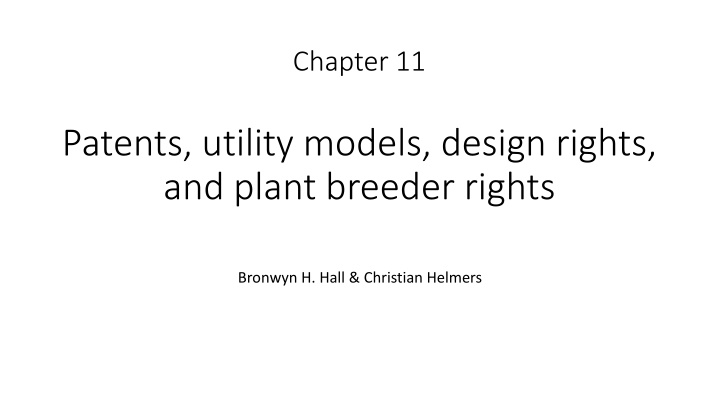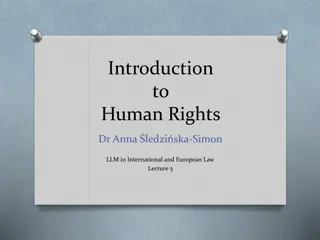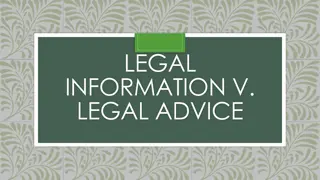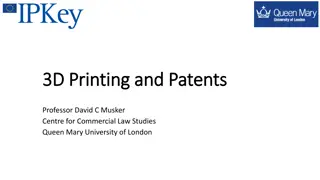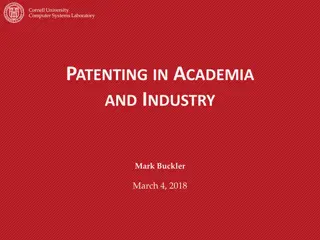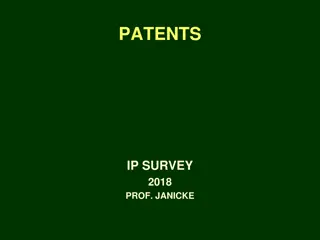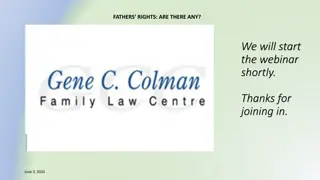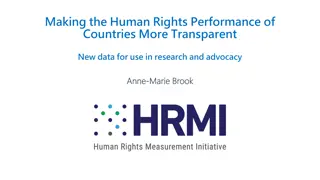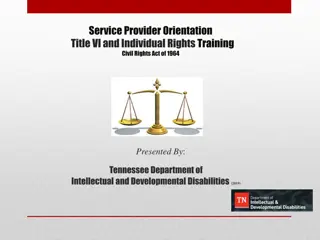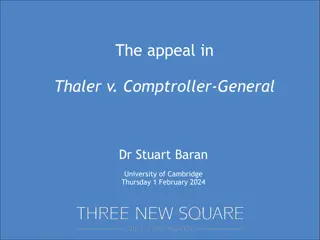Overview of Patents and Legal Rights
Patents grant exclusive rights to inventions, promoting innovation and protecting creators. Learn about patent systems, processes, and requirements, tracing back to historical origins. Understand the significance of patent quality and value, along with utility models, design patents, and plant patents.
Download Presentation

Please find below an Image/Link to download the presentation.
The content on the website is provided AS IS for your information and personal use only. It may not be sold, licensed, or shared on other websites without obtaining consent from the author.If you encounter any issues during the download, it is possible that the publisher has removed the file from their server.
You are allowed to download the files provided on this website for personal or commercial use, subject to the condition that they are used lawfully. All files are the property of their respective owners.
The content on the website is provided AS IS for your information and personal use only. It may not be sold, licensed, or shared on other websites without obtaining consent from the author.
E N D
Presentation Transcript
Chapter 11 Patents, utility models, design rights, and plant breeder rights Bronwyn H. Hall & Christian Helmers
Overview Patent system: Structure and purpose Process and legal requirements Economics of patents Patent quality and patent value More briefly: Utility models Design patents Plant patents 2024 Hall & Helmers Ch. 11 2
Introduction Patent gives owner right to exclude everyone else from exploiting patented invention. Patent owner can sue for patent infringement in court if third party makes, uses, sells, or imports patented invention into jurisdiction where patent is in force. Ability to exclude others often referred to as monopoly over patented invention. Broad legal protection - protects against any use of patented invention. Economic motivation: encourage investment in invention and innovation. 2024 Hall & Helmers Ch. 11 3
Background First (technological) patent granted in 1421 by city of Florence in Italy to Filippo Brunelleschi for new means to transport marble from quarries at Carrara up Arno River. First administrative patent system created in Republic of Venice in 1474: Venetian Patent Statute granted exclusivity over an invention and established an enforcement mechanism. Mandated disclosure and availability of some limited form of compulsory licensing of a patented invention. Required inventions to be novel and non-obvious and practical demonstration of usefulness. 2024 Hall & Helmers Ch. 11 4
Background 2024 Hall & Helmers Ch. 11 5
Background 2024 Hall & Helmers Ch. 11 6
Patent procedures - patentability Patents are government-granted, registered IP rights. Protection only available for patentable subject matter (e.g. laws of nature and natural phenomena excluded). To obtain protection, applicant must apply for a patent with relevant patent office. Patent office grants patent protection if patent application meets patentability requirements: Novelty: invention has to be new, i.e. not already disclosed to public through prior publication, product offered for sale, or public use. Non-obviousness (inventive step): invention has to be more than an obvious -- to a person having ordinary skill in the art (PHOSITA) -- extension of something that already existed before patent s priority date. Utility (industrial application): invention has to have specific and substantial use. 2024 Hall & Helmers Ch. 11 7
Patent procedures - dates Filing date is date when patent application is filed with a patent office. Priority date is first filing date of a patent. Distinguish between first filing date (priority date) and other filing dates because patents can be filed in different jurisdictions within 12 months of the first filing date. All patent offices where patent filed afterwards will have later filing date but same priority date (first filing date) for examination. Priority dates also important because in some jurisdictions, applicants can file subsequent applications based on earlier filings (e.g. continuations in U.S.). Publication date is when patent disclosed to public, 18 months counting from priority date. 2024 Hall & Helmers Ch. 11 8
Patent procedures - expiration and renewal Valid for maximum of 20 years counting from date of filing. Depending on jurisdiction, limited extensions beyond 20 years available. To keep patent in force during statutory lifetime, payment of maintenance (renewal) fees required. Patent expires if: Reaches limit of statutory patent term. Lapses due to non-payment of renewal fees. Once expired, patent can no longer be infringed and patented invention enters public domain. 2024 Hall & Helmers Ch. 11 9
Patent document Claims of Nintendo s Game controller patent US 9,751,008: A game controller which is removably attachable to a main unit having a main unit-side slide member and configured to execute a game process, the game controller comprising: an operation section; and a controller-side slide member protruding from a first surface of the game controller and configured to slidably engage with the main unit-side slide member in a slide direction, wherein: the controller-side slide member has a first end and a second end inthe slide direction; the game controller is configured to be attached to the main unit by inserting the controller-side slide member into the main unit-side slide member from the first end; the game controller includes a stop member configured to resist a slide movement, in an opposite direction, of the controller-side slide member against the main unit-side slide member, the opposite direction being a direction opposite to a direction in which the controller-side slide member is inserted into main unit-side slide member; and the stop member is configured to protrude from the first surface of the game controller or from a side surface of the controller-side slide member, which side surface is substantially perpendicular to the first surface, and the stop member is on the second end side of a center of the controller-side slide member in the slide direction. 2024 Hall & Helmers Ch. 11 10
Patent document A patent consists different elements: Summary Description Claims Drawings Patent claims most important element from legal perspective. Disclose and define legal boundaries of invention. These boundaries often referred to as patent scope or breadth. Claim types: Product claims: device, embodiment, or chemical compound or substance. Process claims: specific method of making or using a product. 2024 Hall & Helmers Ch. 11 11
Patent classification For purposes of prior art search during examination, patents categorized into hierarchical patent classifications according to technologies that they cover. Different patent classifications: International Patent Classification (IPC) system established in 1971 to provides harmonized hierarchical system to classify technology contained in patents. U.S. Patent Classification (USPC) system Cooperative Patent Classification (CPC) system created by EPO and USPTO (similar to IPC) Example: Apple s patent US 8,289,400 Image capturing device having continuous image capture : Covers technology designed to improve quality of photos taken with iPhone. 13 IPCs, all with a main class H04N, one of which is IPC symbol H04N 5/144: H: section Electricity H04: class Electric Communication Technique H04N: subclass Pictorial Communication H04N 5: main group Details of television systems H04N 5/144: subgroup Movement Estimation 2024 Hall & Helmers Ch. 11 12
Patent classification Main purpose of patent classifications to facilitate prior art search. Patent classes do not map directly into technology areas that correspond to areas of economic activity. Correspondences that link technology classes to economic activity: Concordance by Schmoch (2008): Maps IPC classes into 35 broad areas of technology. For example, IPC H04N 5/144 maps into Audio-visual technology within broad technology area Electrical Engineering . Mapping IPC classes more directly to economic activity challenging because technologies often used in wide range of economic activities. Lybbert and Zolas (2014) use keyword matching to map IPC classes to different classifications of economic activity, e.g. Standard International Trade Classification (SITC) and International Standard Industrial Classification (ISIC). H04N corresponds to several industry classes including Photographic apparatus and equipment . 2024 Hall & Helmers Ch. 11 13
Inventor- and Ownership Patent system separates inventorship from ownership. Inventor: anyone who contributed to any of the essential elements of the invention. In practice, often several inventors (co-inventors). Owner (assignee) - not necessarily the inventor: ownership can be transferred at any point during lifetime of a patent. 2024 Hall & Helmers Ch. 11 14
International dimension Patents are national rights. Only enforceable in countries where they have been granted. 1883 Paris Convention established national treatment of foreigners. Facilitates filing of patent applications in multiple jurisdictions by establishing priority right. Patents that protect same invention in different countries belong to same patent family. WIPO s Patent Cooperation Treaty (PCT) of 1970 simplifies application procedure of obtaining patent protection in multiple countries. 2024 Hall & Helmers Ch. 11 15
International dimension 1994 TRIPS agreement increased international harmonization of patent system. TRIPS specified minimum standards of IP protection: Mandated granting of both product and process patents. Statutory patent term of 20 years. Developing countries accorded transition periods depending on level of development to implement agreement. TRIPS lead to substantial strengthening of patent protection in most developing countries. 2024 Hall & Helmers Ch. 11 16
International dimension Regional patent systems: African Regional Intellectual Property Organization (ARIPO) Organisation Africaine de la Propri t Intellectuelle (OAPI) Eurasian Patent Convention European Patent Convention (EPC). EPC most important regional patent system. 2024 Hall & Helmers Ch. 11 17
European Patent Convention (EPC) Created in 1973, it currently has 38 member and 2 extension states. EPC not part of the European Union (EU) but all EU countries are member states of EPC. EPC provides single route to obtaining a patent grant in all member and extension states. EPC created EPO, which centrally accepts patent applications, examines them, and grants the European patent. Granted patent has to be validated in each member state in which protection is wanted and the patent is then subject to national law. Validation process is complex, validation requirements differ across countries. EPC coexists with national patent systems, applicants have choice to obtain patent protection either directly via the national patent system or via the EPO. 2024 Hall & Helmers Ch. 11 18
International dimension Advantage of European patent is central examination. Drawback is that once granted and validated, European patent needs to be enforced separately in each member state. Fragmented national enforcement can lead to inconsistent outcomes (Mejer and van Pottelsberghe, 2012). European patent with unitary effect (Unitary Patent) created in 2012. Currently 18 states that participate in the Unitary Patent system, which became operational in June 2023. Unitary Patent has unitary effect and therefore does not require validation in those 18 individual member states. Enforcement occurs at newly formed Unified Patent Court (UPC). 2024 Hall & Helmers Ch. 11 19
The economics of patents Patents generally strongest of IP rights. Property right that grant owners broad legal protection. Considerable uncertainty associated with validity and scope. Trade-off involved in patent protection: Innovator obtains positive profit which incentivizes innovation. Patent protection results in deadweight loss due to higher price. 2024 Hall & Helmers Ch. 11 20
The economics of patents Trade-off important for optimal design of patent system. What is the optimal duration of patent protection? Increase in patent protection will increase profits and thereby marginal incentive to invest in R&D. Increased incentives are not always necessary or even desirable. Uniform patent protection grants too much or too little protection. Fixed patent life is not optimal in theory, although it may be unavoidable in practice (Nordhaus, 1972: 34). How much protection does patent provide? If protection imperfect, competitors can invent around patent. Less market power despite patent protection. Possibility of duplication of R&D expenses if firms engage in so-called patent races . 2024 Hall & Helmers Ch. 11 21
Patent quality and patent value Economics literature on the patent system often refers to patent quality . Often invoked in policy debates on the functioning of the patent system. Patent quality not a legal concept and difficult to define. Patent quality refers to legal quality of patent right and quality of underlying invention. Related concept is patent value . Patent value refers to value of owning patent and value of underlying invention. Value of patented invention may be private or social. 2024 Hall & Helmers Ch. 11 22
Quality and value of the patent right Hall and Harhoff (2004: 991) defined high quality patent as: Describe inventions that are truly new, rather than inventions that are already in widespread use but not yet patented. Enable those skilled in the art to comprehend the invention well enough to use the patent document to implement the described invention. Have little uncertainty over [their] validity and the breadth of [their] claims. Patent quality determined by actual implementation of statutory patentability requirements by patent offices during examination. Patent quality represents degree to which patent office implements legal standards for granting patents. Distinct from patent strength which refers to degree of protection afforded by a patent system (e.g. longer statutory patent life results in stronger patents). 2024 Hall & Helmers Ch. 11 23
Quality and value of the patent right Value of patent right is value of excluding others from practicing invention. Patent owner who lets patent lapse can still practice invention. Measuring value challenging given its correlation with underlying value of invention. Value of patent can diverge from value of underlying invention. Measure value of patent right itself by estimating renewal value of patent. Captures incremental value of legal protection provided by patent. 2024 Hall & Helmers Ch. 11 24
Quality and value of the patent right 2024 Hall & Helmers Ch. 11 25
Quality of the patented invention Distinction between quality and value of patented invention less clear. Quality means intrinsic value of invention as an inventive step, or contribution to knowledge: For society, value and quality of invention the same. For owner, patented invention may create considerable value without being of high quality. In practice, measure quality of patented invention by proxying it through observable patent characteristics. Lanjouw and Schankerman (2004) treat patent quality as a common factor: [w]e call the common factor quality because we find it difficult to think of any other characteristic that would be common to all patent characteristics included in the model (Lanjouw and Schankerman, 2004: 448): ???= ?+ ???+ ?? yki denotes characteristic k (with k=1, ,K) of patent i; ?? are factor loadings; ??? is a random normally distributed error term. qi is latent patent quality to be estimated. 2024 Hall & Helmers Ch. 11 26
Private value of the patented invention Private value generally not same as social value or quality because it ignores deadweight loss and spillovers. Private value of patented inventions important for: Policy (to determine gap between private and social value). Private companies in making their business decisions. Private value of a patented invention and private value of a patent intrinsically connected. Profits or market value associated with patent reflects combined value of patent right and underlying invention. Value varies across technologies and institutional settings across jurisdictions. Value of a patent depends on firm s portfolio. 2024 Hall & Helmers Ch. 11 27
Private value of the patented invention 2024 Hall & Helmers Ch. 11 28
Private value of the patented invention Estimate patent value based on firm s stock market value and patent holdings (Griliches, 1981). Provides estimates of patent value by obtaining estimate of marginal effect of additional patent on firm s market value. Approach allows separating value of patent from invention inputs by including not only patent count measure but also R&D input. Griliches (1981) used a small sample of 157 U.S. publicly traded firms for period 1968-1974 to obtain an average patent value of US$200,000 (about $718,000 in 2022). 2024 Hall & Helmers Ch. 11 29
Private value of the patented invention Regression of Tobin s Q on patent-stock ratio: ??? ??? = log??+ log 1 + ???? log???= log + ??? ??? where K is proxied by firm i s stock of patents. Change in value from one unit increase in patent stock: ???= ??? ???= ??? Value of an additional patent to US firms: 0.6-1.2 million 1987 dollars during 1976-1992 period (Hall et al., 2005) 5.4 million 1982 dollars during 1976-2006 period (Kogan et al., 2017) 2024 Hall & Helmers Ch. 11 30
Utility models Utility model protection originated in UK in 1843 with utility designs : Created protection for designs with functional features. Utility designs abolished in 1919 by Patents and Designs Act. Germany created utility model protection in 1891: Offer protection for inventions excluded from patentability. German patent system required a showing of a technical advance which effectively excluded many inventions from patentability. Process inventions excluded from utility model protection. 2024 Hall & Helmers Ch. 11 31
Utility models German utility model ( Gebrauchsmuster ): Requires registration but no substantive examination. 6-months grace period. Valid for 10 years counting from application date. Granted much faster than patents and prosecution significantly cheaper. Novelty only focuses on written prior disclosure anywhere in world and use in Germany. Possible to convert patent into utility model while patent pending ( branching-off ) and obtain both patent and utility model on same invention. Advantages of utility model relative to patent: Granted quickly. Novelty requirement lower. Cheaper to obtain. Can be used in addition to a national or European patent. Utility models are predominantly used to protect technical inventions that have a relatively short commercial life or as complements to regular patent protection. 2024 Hall & Helmers Ch. 11 32
Utility models 2024 Hall & Helmers Ch. 11 33
Utility models Utility models ( petty patents , small patents ) not available in all jurisdictions around the world. Available in China, Japan, and Germany, not available in U.S., UK, EUIPO. Significant differences in legal requirements and type of protection afforded across jurisdictions. TRIPS does not mandate granting of utility models. Paris Convention establishes priority right for utility models and PCT extends to utility models. 2024 Hall & Helmers Ch. 11 34
Design rights Volkswagen alleged that Verotec Wheels Inc infringed Volkswagen s design patent D721,028. Volkswagen claimed that [t]he designs are so similar as to be nearly identical such that an ordinary observer, giving such attention as a purchaser usually gives, would be so deceived by the substantial similarity between the designs so as to be induced to purchase Defendants products believing them to be substantially the same as the design protected by the 028 patent. 2024 Hall & Helmers Ch. 11 35
Design rights Apple sued Samsung in 2011 among other for infringement of three of its design patents that protect look of iPhone. Apple alleged that Samsung has misappropriated Apple s patented mobile phone design in the accused products, including the Samsung Galaxy mobile phone . 2024 Hall & Helmers Ch. 11 36
Design rights In 2012, a jury found in Apple s favor and imposed a total damages award of over US$ 1 billion. Overturned on appeal, but ultimately design patents were found infringed and damages totaling more than US$500 million awarded to Apple. 2024 Hall & Helmers Ch. 11 37
Design rights Protection for designs varies substantially across jurisdictions. TRIPS only loosely mandates design protection and leaves considerable discretion to individual member states how to protect designs. Designs are protected by: Design patents. Registered and unregistered design rights. Hague Agreement Concerning the International Registration of Industrial Designs facilitates international filing of design rights in different countries. 2024 Hall & Helmers Ch. 11 38
Design rights 2024 Hall & Helmers Ch. 11 39
Design rights Design protection only available for visual appearance of a product. Design dictated by function or purpose of a product not protected. Design patents much simpler than patents: Patent specification consists only of patent title, description, single claim. Scope of protection defined by drawings. Infringement of design patent established through visual test of similarity: do the allegedly infringing design and the protected design look the same or substantially the same ? 2024 Hall & Helmers Ch. 11 40
Design rights In U.S., design patents examined for compliance with patentability requirements: Novelty: ordinary observer familiar with prior art does not believe claimed design is essentially same as existing design. Non-obviousness: design not obvious to designer of ordinary skill that designs articles such as article that incorporates claimed design. Design must be ornamental, not dictated by function. In U.S., design patents not published until granted and valid for 15 years from date of issuance (no maintenance fees). Design protection relatively broad: exclusive right to use a design and any design which does not produce on the informed user a different overall impression . 2024 Hall & Helmers Ch. 11 41
Design rights Economic purpose of design rights: promote investment in development of aesthetic aspects of products. Empirical evidence from Europe suggests that in market for visible automotive spare parts, design protection results in 6% higher prices (Herz and Mejer, 2021). Design rights also offer protection for low-tech products, which otherwise could not benefit from patent or utility model protection. Industries that rely more on design protection are relatively low-R&D intensive, consumer goods industries, such as furnishing, and clothing (Filitz et al., 2015). Help specialization as they allow upstream design firms to license their designs downstream to manufacturers. Enable product differentiation. Benefit in particular smaller firms. 2024 Hall & Helmers Ch. 11 42
Plant patents In U.S., 1930 Plant Patent Act (PPA) created plant patent, to protect new, asexually reproduced plant varieties. PPA motivated by demand by plant breeders for legal protection. Stark Brothers nursery built cage around their Golden Delicious apple tree to prevent competitors from stealing cuttings. 2024 Hall & Helmers Ch. 11 43
Plant patents Grant protection to plant breeders to incentivize private investment in R&D to help domestic plant breeding industry develop. Plant protection motivated by characteristics of plant breeding industry: Costly and lengthy development process of new plant varieties. Substantial commercial uncertainty. Imitation relatively easy and fast: for self-reproducing plant varieties, no reverse-engineering necessary, just access to such varieties sufficient for reproduction. At time of PPA, considerable uncertainty regarding whether existing patent system would provide protection for modified organisms. 2024 Hall & Helmers Ch. 11 44
Plant patents Narrower scope than patents: Cover asexual reproduction of a specific plant grown in cultivation, not seeds, or similar plants. Patentability requirements different: Plant has to be new, distinct and not found in the wild. Provide protection for 20 years counting from filing date. Plant Variety Protection Act (PVPA) in 1970 extended protection in the form of patent-like plant variety protection certificates to sexually propagated plants. In 1980, U.S. Supreme Court in Diamond vs. Chakrabarty extended utility patent protection to living organisms. In 2001, U.S. Supreme Court in J.E.M. Ag Supply Inc. vs. Pioneer Hi-Bred, extended utility patent protection to plant seeds and plants themselves. 2024 Hall & Helmers Ch. 11 45
Plant patents Not all countries grant plant patents or allow plants to be protected by patents (e.g. EPO). Countries grant sui generisprotection in the form of plant breeders rights (PBR): PBRs created in 1961 at International Convention for the Protection of New Varieties of Plants organized by the Union pour la Protection des Obtentions V g tales (UPOV). PBRs provide temporary (20 years) exclusivity over plant varieties. PBRs require a plant variety to be novel (only with respect to commercialization), distinct from existing varieties, and uniform and stable. PBRs may be subject to breeders exception and farmers privileges. TRIPS mandates protection for plant varieties either in the form of patents or sui generis protection such as PBRs. 2024 Hall & Helmers Ch. 11 46
Plant patents Economic importance of plant patents unclear. Plant patents were not the main driving force behind emergence of U.S. rose industry following PPA (Moser and Rhode, 2012). No evidence for any positive impact of 1970 PVPA on private investment in wheat breeding, nor any evidence of increases in experimental or commercial yields of wheat (Alson and Venner, 2002). Introduction of plant variety protection in Australia led to decrease in new wheat variety output due to reduced spillovers in the form of exchange of germplasm between breeders (Thomson, 2015). 2024 Hall & Helmers Ch. 11 47
Summary Main economic argument for granting patent monopoly : temporary exclusivity encourages investment in innovation. Patent system fairly complex and significant differences across jurisdictions. Concepts of patent quality and value widely used in economic literature and policy discussions. Difficult to define and measure in practice. Inventions also protected by utility models, design patents and rights, as well as plant patents and PBRs. 2024 Hall & Helmers Ch. 11 48
